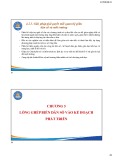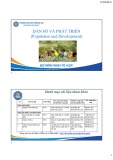
Ecological Anthropology:
Theoretical Approaches
Dr. Annuska Derks

What does Anthropology
contribute to the study of the
environment?
Cross-cultural study of society and environment
Influence Environment on Society
vs
Influence Society on Environment

Ecological Anthropology: An Overview
Early 20th century: Environmental Possibilism
1950s-1960s: Cultural Ecology
1960s-1980s: Ecological Anthropology:
Neofunctionalism
1990s-now: Ecological Anthropology: New
Ecologies / Processual Approaches

3 theoretical approaches
Cultural Ecology – Julian Steward
Ecosystem Approach – Roy Rappaport
Cultural Materialism – Marvin Harris

Cultural Ecology
Julian Steward (1902-1972)
Effect of environment upon culture
Ecology = „adaptation to environment“
Cultural ecology = study of adaptation to environment
by means of culture; in the larger sense, the problem is
to determine whether similar adjustments occur in
similar environments







![Bài giảng Dân số và Phát triển - Chương 4: Dân số, tài nguyên và môi trường [Mới nhất]](https://cdn.tailieu.vn/images/document/thumbnail/2022/20220606/charaznable/135x160/4991654490047.jpg)




![Cẩm nang Thanh niên hành động [Mới nhất]](https://cdn.tailieu.vn/images/document/thumbnail/2025/20251017/kimphuong1001/135x160/1521760665202.jpg)




![Bài giảng Công tác xã hội: Khái niệm, phân biệt, quan hệ và chức năng [Chuẩn Nhất]](https://cdn.tailieu.vn/images/document/thumbnail/2025/20251002/littlehippy91/135x160/63461759457333.jpg)
![Tài liệu học tập Nhập môn Công tác xã hội [mới nhất]](https://cdn.tailieu.vn/images/document/thumbnail/2025/20251002/littlehippy91/135x160/50611759457334.jpg)
![Nội dung ôn thi Xã hội học đại cương [chuẩn nhất]](https://cdn.tailieu.vn/images/document/thumbnail/2025/20250930/kisu6910@gmail.com/135x160/12931759283279.jpg)






